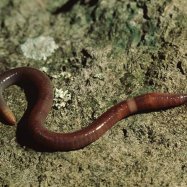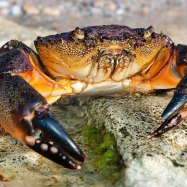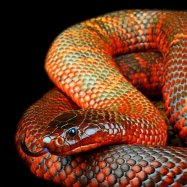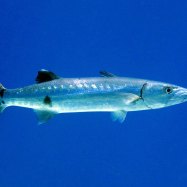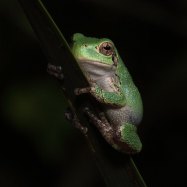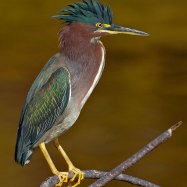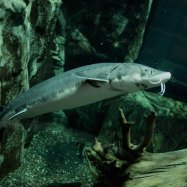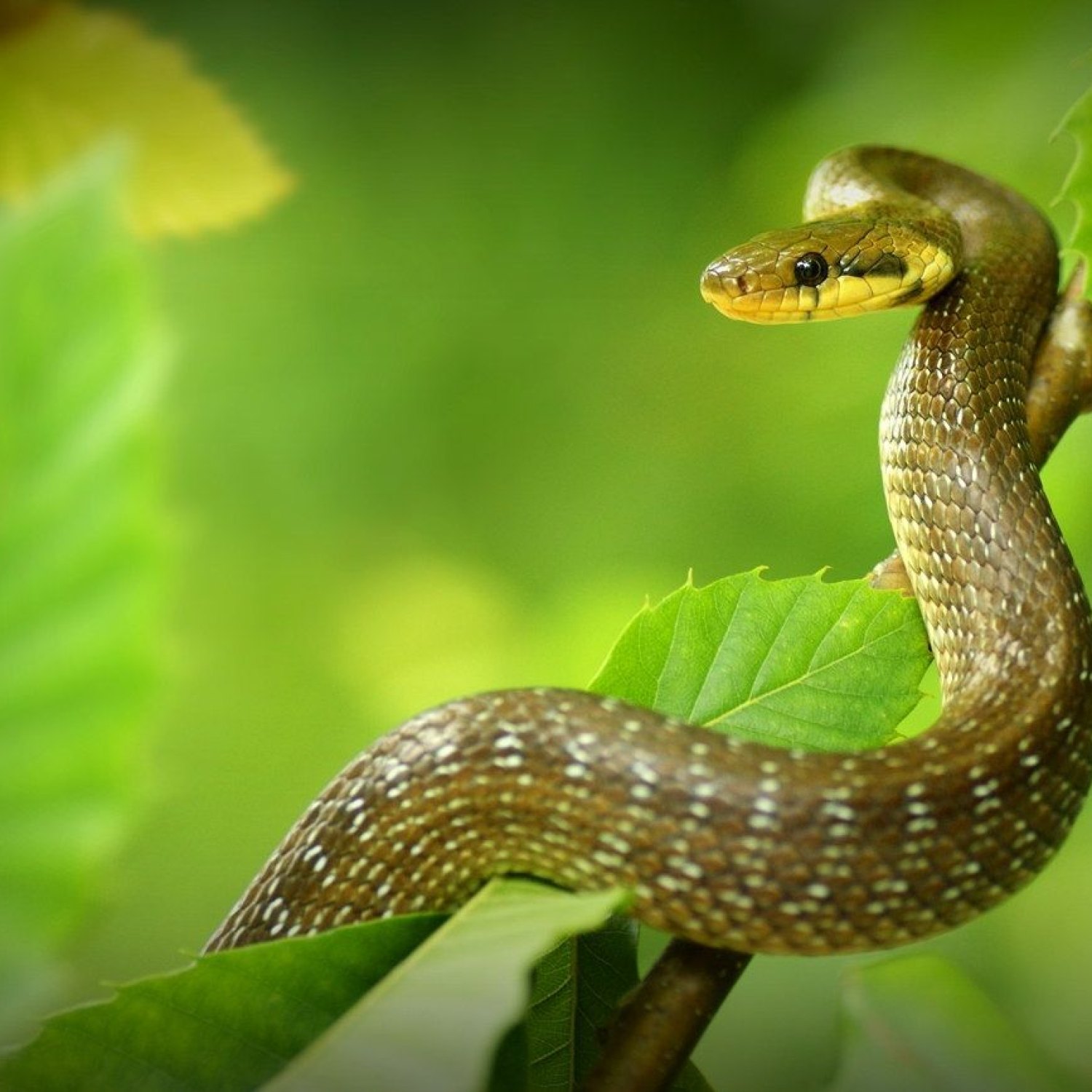
Aesculapian Snake
up to 2 meters
The Aesculapian snake, also known as the Zamenis longissimus, is a non-venomous snake commonly found in trees, rocks, and shrubs. With a slender and elongated body, it can grow up to 2 meters in length. Belonging to the Colubridae family, this fascinating snake is a skilled climber and can often be seen basking in the sun on trees and rocks. Keep an eye out for this stunning creature on your next nature walk! #AesculapianSnake #NatureFacts
Animal Details Summary:
Common Name: Aesculapian Snake
Kingdom: Animalia
Habitat: Forests, woodlands, meadows, rocky areas
The Mysterious Aesculapian Snake: The Serpent of Life
The serpent is a symbol of healing and rebirth, a creature that has been revered and feared for centuries. Its long, slender body, mesmerizing gaze, and secretive behavior have inspired countless tales and myths. This reptilian wonder is none other than the Aesculapian Snake, scientifically known as Zamenis longissimus.The Aesculapian Snake is an enchanting and elusive species, found in the woodlands and meadows of Europe and Western Asia Aesculapian Snake. Its name comes from the Greek god of medicine, Asclepius, who was often depicted with a staff entwined by a snake. But what is it about this creature that has captured our imagination and made it a symbol of healing and life? Let's delve deeper and unravel the mysteries of this extraordinary species.
A Remarkable Classification
Before we dive into the intriguing aspects of the Aesculapian Snake, let's take a closer look at its classification. As a member of the Animal Kingdom, the Aesculapian Snake belongs to the phylum Chordata, which includes all animals with a spinal cord. From there, it falls under the class Reptilia, along with other scaly creatures.The Aesculapian Snake is part of the order Squamata, which translates to "scaled reptiles." This order includes lizards, snakes, and amphisbaenians. Within the order Squamata, the Aesculapian Snake belongs to the Colubridae family, which is the largest family of snakes. This family includes over two-thirds of all known snake species Arctic Wolf.
With its unique physical and behavioral traits, the Aesculapian Snake has earned its own genus, Zamenis, which is derived from the Greek word for "elderly." This refers to the snake's long lifespan, which can reach up to 20 years in the wild. The species name, longissimus, is also a nod to its long, slender body, with the Latin word "longus" meaning long.
The Aesculapian Snake's Habitat and Diet
The Aesculapian Snake is a highly adaptable species, found in a variety of habitats, including forests, woodlands, meadows, and rocky areas. It is also known to thrive in urban areas, living in man-made structures such as walls and buildings. This adaptability has allowed the Aesculapian Snake to have a much broader geographical distribution, compared to other snake species.As a carnivorous species, the Aesculapian Snake preys on a wide range of small animals, including birds, mice, lizards, and insects. Its feeding method is quite fascinating, as it subdues its prey by constricting it with its powerful coils, much like its larger cousin, the Boa Constrictor. It then swallows its prey whole, aided by its flexible jaw and expandable throat.
The Aesculapian Snake's Physical Features
The Aesculapian Snake has a distinct dark green or brown coloration, with black scales and a white underbelly. This camouflage allows it to blend seamlessly into its natural surroundings, making it a secretive and elusive creature. Its body is slender and elongated, with a smooth and glossy skin that glistens in the sunlight.The Aesculapian Snake is a non-venomous species, with no fangs or venom glands. However, it does have a set of small, sharp teeth that can deliver a painful bite if threatened. Its jaw is also powerful enough to crush small bones, giving it an advantage when hunting.
The Aesculapian Snake's Behavior
One of the most intriguing aspects of the Aesculapian Snake is its arboreal behavior, meaning it is adapted to living in trees. This is quite rare among snake species, making the Aesculapian Snake stand out even more. It is also active during the day, making it diurnal, unlike most snakes that are nocturnal.Despite its secretive nature, the Aesculapian Snake is known to be a non-aggressive and docile species, rarely attacking humans unless provoked. When threatened, it will hiss loudly and display an open-mouthed warning, often flattening its head and body, imitating a venomous snake. However, its behavior in the wild is quite reclusive, and it prefers to avoid confrontation and hide from potential threats.
A Lost Species Rediscovered
While the Aesculapian Snake is still prevalent in many parts of Europe and Western Asia, it was once considered extinct in the United Kingdom. The last sighting of the Aesculapian Snake in Britain was in 1975, and it was assumed that the population had died out due to habitat loss and persecution.However, in 2020, a team of herpetologists stumbled upon an Aesculapian Snake population in an abandoned zoo in London. This rediscovery has reignited interest in this species and highlighted the importance of conservation efforts. With proper protection and conservation measures, the Aesculapian Snake could once again thrive in the United Kingdom.
The Role of the Aesculapian Snake in Mythology and Medicine
The Aesculapian Snake is not only a fascinating species in nature, but it has also played a significant role in human history and culture. Its association with the Greek god of medicine, Asclepius, has made it a symbol of healing and rejuvenation. Asclepius was said to have the power to bring the dead back to life, and the Aesculapian Snake was his symbol of transformation and immortality.In Ancient Greece, the Aesculapian Snake's skin was often used in healing rituals, as it was believed to have medicinal properties. It was also believed that the Aesculapian Snake possessed divine knowledge and was often consulted by healers for guidance and insight. This reverence for the snake has continued through the centuries, with Aesculapian Snakes appearing in medical emblems and symbols, even to this day.
A Species Worth Protecting
Despite its widespread distribution, the Aesculapian Snake is facing several threats that could potentially impact its population. Habitat destruction, fragmentation, and pollution are the primary concerns for this species, as they rely heavily on specific habitats for their survival. The decline of prey species due to intensive agriculture and urbanization is also a threat to the Aesculapian Snake's food source.Another major threat to the Aesculapian Snake is illegal collection for the pet trade. Due to its unique physical features, it is often sought after as an exotic pet. This illegal trade not only harms the individual snakes but can also have a significant impact on the wild populations.
The Importance of Conservation Efforts
With its unique features and vital role in human history, the Aesculapian Snake is a species worth protecting. Conservation efforts such as habitat restoration, captive breeding, and public education are essential in ensuring their survival. The rediscovery of the Aesculapian Snake in Britain is a testament to the importance of conservation efforts and the potential for successful species recovery.In countries where the Aesculapian Snake is still prevalent, there are also actions that can be taken to minimize threats to their populations. These include creating protected areas and implementing strict regulations on the pet trade. By working together to protect this species, we can ensure that the Aesculapian Snake is not just a symbol of healing, but a species that continues to thrive in the wild.
In Conclusion
The Aesculapian Snake is a mesmerizing and enigmatic creature, with a rich history and significant role in the ecosystem. Its adaptability and unique traits have allowed it to thrive in a variety of habitats, making it one of the most widespread snake species. However, with various threats to its population, it is crucial that we work towards protecting and preserving this species for future generations.Whether we view it as a symbol of life and healing or simply appreciate its beauty and resilience, the Aesculapian Snake is a species that is worth getting to know and protecting. Let us continue to marvel at this magnificent serpent of life and work towards creating a world where it can thrive alongside us in harmony.

Aesculapian Snake
Animal Details Aesculapian Snake - Scientific Name: Zamenis longissimus
- Category: Animals A
- Scientific Name: Zamenis longissimus
- Common Name: Aesculapian Snake
- Kingdom: Animalia
- Phylum: Chordata
- Class: Reptilia
- Order: Squamata
- Family: Colubridae
- Habitat: Forests, woodlands, meadows, rocky areas
- Feeding Method: Carnivorous
- Geographical Distribution: Europe and Western Asia
- Country of Origin: Various countries in Europe
- Location: Trees, rocks, and shrubs
- Animal Coloration: Dark green or brown, with black scales and white underbelly
- Body Shape: Slender and elongated
- Length: up to 2 meters
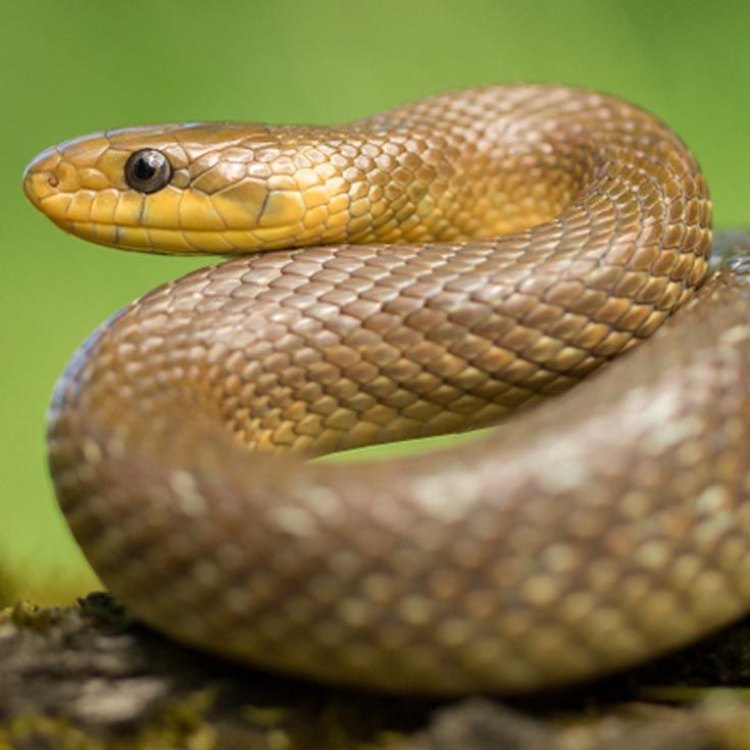
Aesculapian Snake
- Adult Size: Large
- Average Lifespan: 10-15 years
- Reproduction: Oviparous (egg-laying)
- Reproductive Behavior: Mating occurs from April to June
- Sound or Call: Hissing sound when threatened or disturbed
- Migration Pattern: Non-migratory
- Social Groups: Solitary
- Behavior: Diurnal (active during the day)
- Threats: Habitat loss, road mortality, persecution
- Conservation Status: Least Concern
- Impact on Ecosystem: Maintains balance in the ecosystem by controlling populations of prey species
- Human Use: Not used by humans
- Distinctive Features: Long, slender body and smooth scales
- Interesting Facts: One of the few snake species that can climb trees
- Predator: Birds of prey, mammals
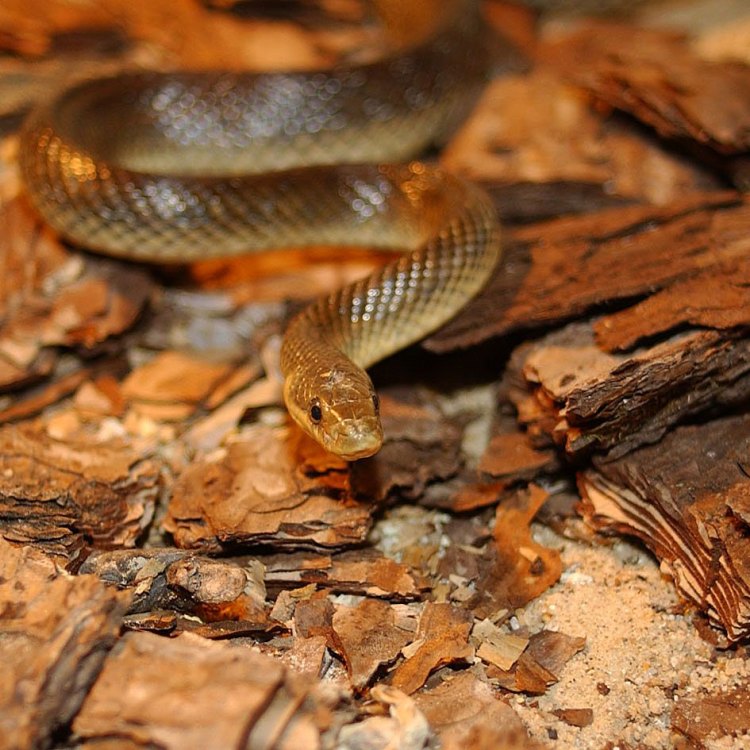
Zamenis longissimus
Exploring the Secret World of the Aesculapian Snake: A Sentinel of the Ecosystem
The world of snakes is often shrouded in mystery and fear. These fascinating reptiles have been vilified and misunderstood for centuries, with many species facing the threat of extinction due to human activities. But amidst the fear and misconceptions, there exists a truly unique and magnificent creature - the Aesculapian Snake.With its long, slender body and smooth scales, the Aesculapian Snake is a snake like no other PeaceOfAnimals.Com. Its distinctive features and interesting behaviors have captivated the minds of scientists and nature enthusiasts alike. In this article, we will delve into the world of the Aesculapian Snake and discover its secrets, from its impressive size and lifespan to its important role in maintaining balance in the ecosystem.
The Giant of the Snake World
The Aesculapian Snake, also known as the Esculapian Snake or Zamenis longissimus, is Europe's largest nonvenomous snake. It can reach lengths of up to 2 meters (6.5 feet) and can weigh up to 2.5 kilograms (5.5 pounds). With this impressive size, it is no wonder that the Aesculapian Snake has earned the title of the "giant of the snake world."But don't let its size intimidate you Angled Sunbeam Caterpillar. The Aesculapian Snake is a harmless species, making it a valuable ambassador for its kind. Despite its large size, it is a relatively docile and non-aggressive snake, preferring to escape and hide when faced with danger rather than attack. This peaceful demeanor is one of the many reasons why this species is a favorite among researchers and wildlife enthusiasts.
A Lifetime of 10-15 Years
The Aesculapian Snake may be a giant in the snake world, but it is not immortal. Like all living creatures, it has a limited lifespan. On average, this species lives for 10-15 years in the wild, though some individuals have been known to live for up to 20 years. This lifespan is shorter compared to other snake species, such as the ball python which can live for over 30 years.The Wonders of Reproduction
Reproduction is a remarkable process in any species, and the Aesculapian Snake is no exception. As an oviparous species, they reproduce by laying eggs. In the wild, mating occurs from April to June, with females producing an average of 8-12 eggs in one clutch. These eggs are then incubated for 9-11 weeks before hatching.Interestingly, the sex of the hatchlings is determined by the temperature inside the nest during incubation. Warmer temperatures tend to produce more females, while cooler temperatures result in more males. This adaptation allows the species to maintain a healthy balance in its population.
Solitary Yet Social
Unlike some snake species that are known to form groups, the Aesculapian Snake is largely solitary. They are most active during the day, patrolling their territories and searching for prey. However, during mating season, males may engage in competition for females, sometimes forming small aggregations.But even as solitary creatures, the Aesculapian Snake plays an important role in maintaining balance in the ecosystem.
The Sentinel of the Ecosystem
As a predator, the Aesculapian Snake feeds on a diverse range of prey, including rodents, birds, lizards, and small mammals. This crucial role as a top predator helps to regulate the populations of these prey species, preventing overpopulation that can have negative effects on the ecosystem.For instance, in areas where the Aesculapian Snake has declined due to habitat loss or persecution, there has been an increase in the population of rats, which can cause damage to crops and spread disease. As such, the Aesculapian Snake is often considered a "sentinel" of the ecosystem, indicating the overall health and balance of the environment.
The Plight of the Aesculapian Snake
Despite its vital role in the ecosystem, the Aesculapian Snake is facing numerous threats that have led to a decline in its population. Habitat loss, caused by human activities such as agriculture, urbanization, and deforestation, is one of the top threats to this species.Another major cause of decline is road mortality, with many snakes falling victim to vehicle collisions as they try to cross roadways. This issue is particularly prevalent in areas where roads cut through their natural habitat, disrupting their movement and increasing the risk of mortality.
Unfortunately, the Aesculapian Snake also faces persecution from humans. Due to their large size and general lack of fear, they are often mistaken for dangerous or venomous snakes and are killed out of fear or misunderstanding.
Standing Strong: Conservation Status
Despite these threats, the Aesculapian Snake is currently listed as a species of Least Concern on the International Union for Conservation of Nature (IUCN) Red List. This means that the species is not in immediate danger of extinction, thanks to its wide distribution across Europe and its ability to adapt to various habitats.However, conservation efforts are still needed to ensure the long-term survival of this species, particularly in areas where they are facing declining populations. Measures such as habitat protection, public education, and road mitigation can all help to safeguard the Aesculapian Snake and allow it to continue playing its vital role in the ecosystem.
The Silent Guardians of our Ecosystem
As we go about our busy lives, it is easy to overlook the presence and importance of certain species in our surroundings. The Aesculapian Snake may not be as well-known as some other snake species, but it plays a crucial role in maintaining the balance and health of our ecosystem.From its impressive size and lifespan to its interesting behaviors and vital role as a top predator, the Aesculapian Snake has truly earned its place as one of the most fascinating creatures in the animal kingdom. Let us take a moment to appreciate and protect these silent guardians of our ecosystem, for without them, our world would not be the same.
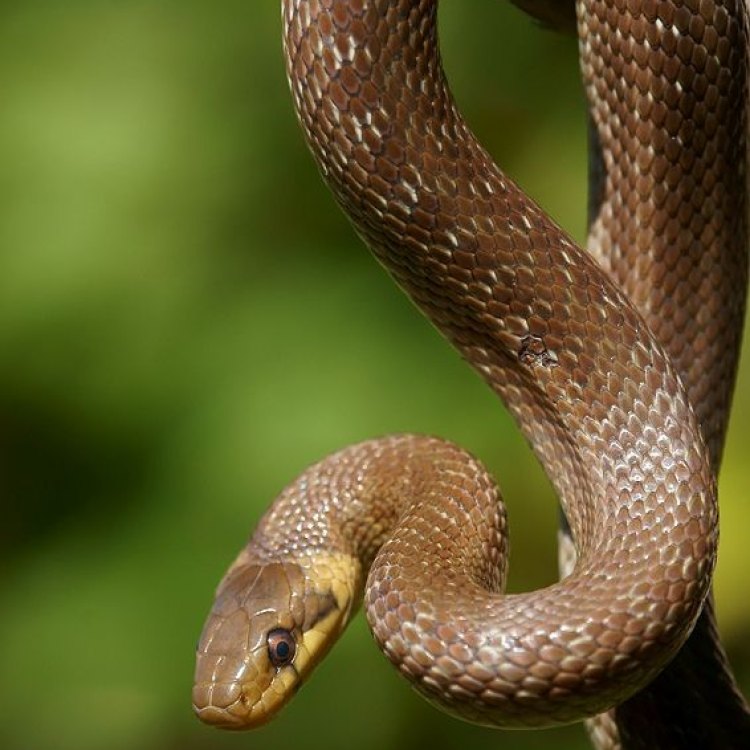
The Mysterious Aesculapian Snake: The Serpent of Life
Disclaimer: The content provided is for informational purposes only. We cannot guarantee the accuracy of the information on this page 100%. All information provided here may change without prior notice.

